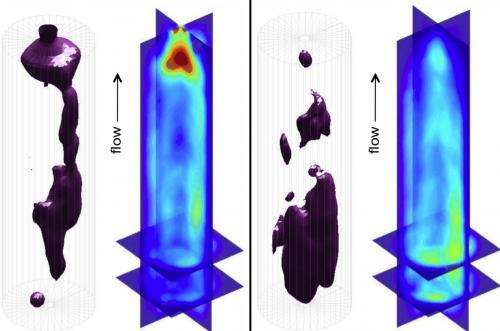SPECT maps 3-D changes in soil samples, may shed light on bioremediation

The same medical imaging technology that doctors use to noninvasively image the heart and brain is now giving scientists a close-up view of the subsurface world. Berkeley Lab scientists are developing a way to use Single Photon Emission Computed Tomography, or SPECT, to map 3-D changes in sediment samples without disturbing them.
Their work could help improve the clean up of soil contaminants such as heavy metals. It could also help researchers learn how to best store carbon underground, where it can't contribute to climate change.
The latest results of this research, led by Bill Moses of Berkeley Lab's Life Sciences Division and Peter Nico of the Earth Sciences Division, were reported Dec. 6 at the 2012 meeting of the American Geophysical Union (AGU) in San Francisco.
In the medical use of SPECT, a patient is given a radioactive drug that targets something doctors want to image, such as a tumor or metabolic activity. A gamma camera then images the presence of the radiation emitted by the drug, and a computer constructs the data into a 3-D image.
So how did this technology make the leap from the hospital to geology lab? It was a combination of a stubborn problem and the close proximity of world-class research.
Scientists in Berkeley Lab's Earth Sciences Division are at the vanguard of understanding how fluid-borne contaminants, nutrients, and microbes move underground. As part of this research, they study meter-long tubes packed with sediment, also called soil columns. The columns mimic underground conditions and are one of the best ways to observe what happens at a tough-to-study scale that's larger than a few centimeters and smaller than hundreds of meters. But it's a tedious process, which is where the problem comes in: the soil columns must be broken apart and chemically analyzed to determine what's happening inside.
In a nearby building, researchers in the Life Sciences Division have a long history of developing radiotracers and instrumentation for use in SPECT and PET imaging.
Was there a solution here? Perhaps the same technology that allows doctors to see inside our bodies could also give scientists a way to monitor changes in sediment columns without opening them up. Three years ago, scientists from both divisions began working together to find out.
Their research is paying off. As reported at the AGU meeting, the scientists used SPECT to track two radiotracers as they moved through a column of sediment recovered from the Old Rifle aquifer in Western Colorado. Several imaging studies were conducted over more than 100 days of flow. Geostatistical computer models developed at Berkeley Lab further processed the SPECT data.
The resulting information reveals 3-D changes in the column's permeability over time. It also identifies when and where iron reduction occurs, which is an important component of microbially mediated clean up and other processes. More research is needed, but the Berkeley Lab scientists believe the technique could become a new way to observe changing permeability and microbial activity in sediment at a scale that's useful for bioremediation and carbon storage research.
Provided by Lawrence Berkeley National Laboratory
















